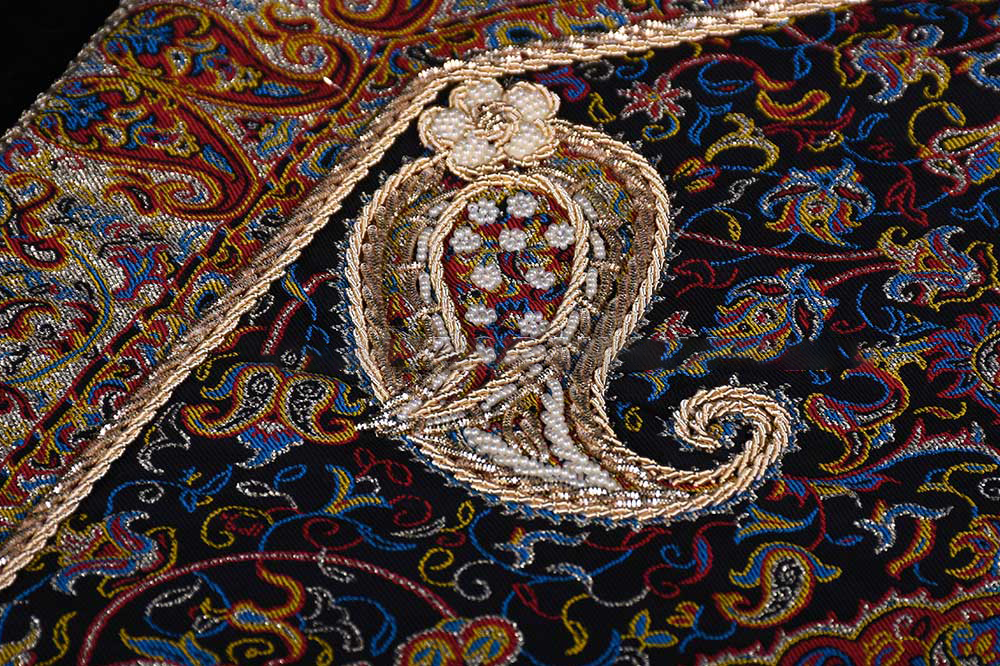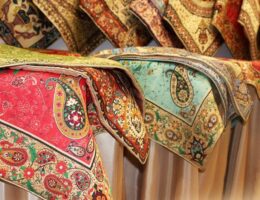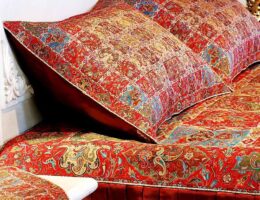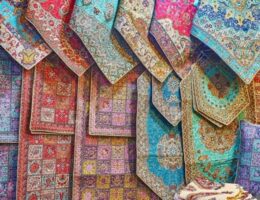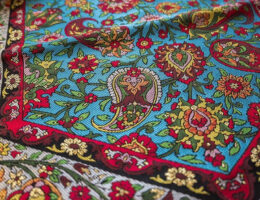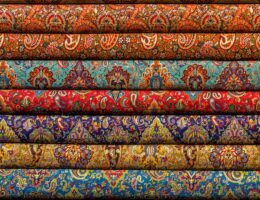IRAN ART EXHIBITION: “SERMEH DOOZI” A TRADITIONAL IRANIAN STYLE OF EMBROIDERY
Sermeh doozi is estimated to date back to the Achaemenid era (c. 550 – 330 BC). In this style of embroidery, gold and silver threads are utilized to make decorating patterns, mostly paisley patterns, on the surface of fabric, mainly termeh, which is a type of expensive Iranian handwoven cloth.
The combination of termeh and gold and silver threads makes Sermeh doozi, which is widely considered as a luxury handicraft product by Iranians.
Samples of Sermeh doozi can be seen on table cloths, flags, embroidered clothing, religious objects, and many household items.
Nowadays, threads twisted out of cheaper metals and alloys and metal like yarns have replaced gold and silver, to make it more affordable for people of all walks of life.
The art, which reached its zenith in the Safavid era (1501–1736) is mostly practiced in the cities of Isfahan, Kashan, Yazd, and Qazvin.
Sermeh-doozi, a forgotten field of handwoven textile that was once flourished in Golbahar county of the northeastern Khorasan Razavi province, has been revived recently by an indigenous artisan, a local tourism official has announced.
Sermeh-doozi was one of the main crafts in the region for years, but it had been fallen into oblivion, CHTN quoted Mohammad Taherian as saying on Sunday.
The craft was revived with the help of an artisan who established a workshop dedicated to the field, the official added.
The craft is now being practiced by 10 people and 25 people are being trained currently, he explained.
A sum of 500 million rials (some $ 12,000 at the official exchange rate of 42,000 rials per dollar) has been invested for the workshop, he noted.
The official noted that a large percentage of handicraft artisans in the county are women, so reviving handicraft fields could significantly boost women’s employment prospects.
Sermeh-doozi is a traditional Iranian style of embroidery, which is estimated to date back to the Achaemenid era (c. 550 – 330 BC).
In this style of embroidery, gold and silver threads are utilized to make decorating patterns, mostly paisley patterns, on the surface of the fabric, mainly Termeh, which is a type of expensive Iranian handwoven cloth.
The combination of Termeh and gold and silver threads constitutes Sermeh-doozi, which is widely considered a luxury handicraft product by Iranians.
Samples of Sermeh-doozi can be seen on table cloths, flags, embroidered clothing, religious objects, and many household items.
Nowadays, threads twisted out of cheaper metals and alloys and metals like yarns have replaced gold and silver to make it more affordable for people of all walks of life.
IRAN ART EXHIBITION: The art, which reached its zenith in the Safavid era (1501–1736) is mostly practiced in the cities of Isfahan, Kashan, Yazd, and Qazvin.
With 14 entries, Iran ranks first globally for the number of cities and villages registered by the World Crafts Council, as China with seven entries, Chile with four, and India with three ones come next.
The Sermeh duzi represents one of Iran’s traditional embroidery and is made with a metallic yarn called Sermeh. In the Sermeh duzi, fabrics such as Termeh, velvet or linen are used. In ancient times, the Sermeh was a resilient gold, silver or alloy yarn that was wrapped – in the shape of a square or rectangle – around a silk yarn. Today, however, it is used in a spring shape. In the past, the Sermeh duzi was considered a merely majestic art whose apex is represented by the embroidered inscriptions on the cloth that covers the Ka’ba. On this drape, the verses of the Koran are sewn, in various Islamic spellings, through the use of the Sermeh. Nowadays, the most important expressions of Sermeh duzi’s art can be found in the tablecloths, in the rutakhti, in the sajjādeh and in the jānamāz (both prayer rugs), in the covers of the Koran and in the paintings found in the Bāzār. Generally, these goods are produced in the cities of Esfahān, Kāshān, Tehrān and Yazd.
Sermeh Duzi is one of the oldest embroideries of Iran. There is no available text regarding the history of this sewing handicraft, however, after examining the decorations of the collars, army and royal clothing and flags of Iranians during history we can be certain that they paid much attention to decorations and producing the necessary yarns. There is no doubt that Sermeh is very close to filigree because they are very similar in type and history. The Sermeh craft flourished during the Parthian empire. During that time, decorative sewing was a part of export good of Iran. One of the handicrafts that made Alexander wondered was gold-brocade fabrics and decorative embroideries of Iran, one of which was Sermeh. There is a Sassanid piece of fabric on which a wine tree has been sewed by Sermeh embroidery. This craft continued during Sassanid dynasty. At the beginning of Islamic Era, the Iranians artists were commissioned to make the drapery of Kaaba which led to this art to reach even higher levels. Short Surahs and Ayahs from the holy Quran were applied by Sermeh Duzi in forms of calligraphies such as Muhaqqaq, Reyhan, Thuluth and Reqa. At first, the texts were written on the fabric by thick yarns such as Gheytan, and then Sermeh was applied on them. This technique gave the fabric a magnificent view. The elegant drapery of Kaaba from Timurid dynasty is now kept at the National Museum of Iran. All kinds of sewing techniques such as silk, Golabatoon, Deh Yek, Kamand, Sharafeh and Sermeh can be seen in this piece.

IRAN ART EXHIBITION: Sermeh Duzi has been highly regarded during the Islamic era. But it flourished in Safavid dynasty. Remaining artifacts of this era are proved of this. There is another piece of drapery kept in the Museum of Decorative Arts of Iran that belongs to the time when Sermeh was at its peak. On this piece, decorated with Animal Mehrab motifs, there are kinds of sewing such as Golabatoon, Dah Yek, Pileh, Sermeh and filigree. During the Afshar, Zand, Qajar dynasty and later, Sermeh Duzi continued and were still common, but lost its quality. Some of the motifs of Sermeh Duzi are “Godani”, “Sahrayi”, “Hashiehee”, “Jenaghi”,”Mehrabi”, “Gol-e Badami”, animal and figurative motifs, kinds of birds especially peacocks and owls, kinds of fruits like a cluster of grapes, stars and paisley. Today this handicraft is still popular in cities of Iran and is applied in decorative tableaus, collars, bust pieces, belts, money bags, tray covers, sugar covers, draperies, cushions and etc.
The last and the most important factor is either the termeh is plain or if it has embroidery. Nowadays most of the Persian termeh are elaboratively embroidered using a technique that is called “Sermeh Doozi”. This is an embroidery technique that was used in ancient Persia and has been taught from one generation to the next.
Sermeh doozy is a prominent needlework used in ancient Persia. It is an embossed technique used on expensive pieces of fabric and clothing ever since. The artist uses a threaded needle and passes it through small delicate pieces of gold embroidery tube (Sermeh) and sews and secures it to the fabric.The designer usually uses pearls and beads too to make the design more glamorous and also outstanding. This sort of embossed work is truly outstanding and one of a kind.
